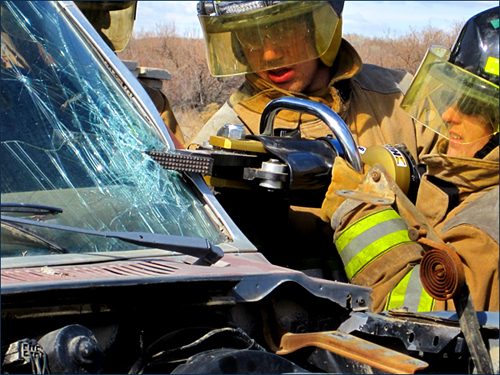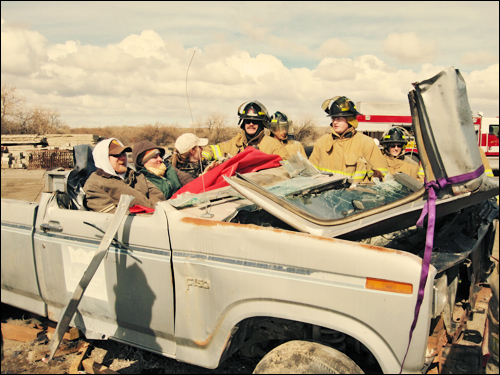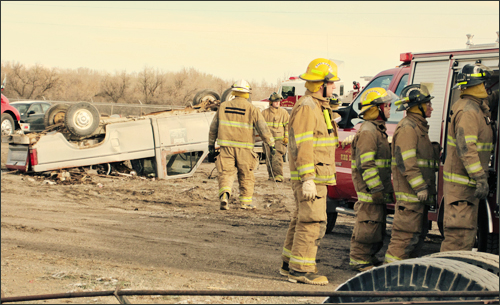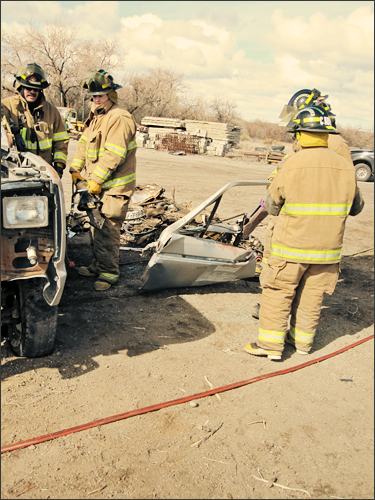This Is Only A Test
My EMT class convenes, early Saturday morning, at a wrecking yard. We are joined by the Fire Department dressed in bunker gear. We’re here to practice extrication: safely removing people from vehicles be they stable, mangled, or flipped (the vehicle, that is ~ we always assume the patient is mangled).
While the Fire Dept practices stabilizing automobiles, we practice moving patients out from various cars and trucks and onto a backboard. I play ‘patient’ at one point and am awed at how smoothly, thanks to proper knowledge and teamwork, I am transferred from wrecked truck to backboard to ambulance.
We join up with the Fire crew to learn about the fearsome tools they use to take apart a vehicle. We watch them in action.
Cutting the A-beams for roof removal:

The top of a truck is folded forward:

After a morning of practice in 30ºF weather with unrelenting 20-mph wind,
“Just like the real thing,” one instructor sadistically cackles, we are corralled in the ambulance as our instructors set up a crash: two vehicles, one on its side, with four moulaged patients trapped inside. Moulage: gory makeup that simulates all sorts of wounds and injury.
My classmates and I, and the Fire rookies, are then called to the scene to assess, extricate and transport these patients, while also tending to the additional patient care that takes place during each stage. The patient I am responsible for is in the backseat of a Bronco, the upright vehicle in the crash.
I have a fireman break the back window of the Bronco for me and I crawl in to manually stabilize my patient in the backseat. I discern his status, talk with him; sometimes, as he drifts out of consciousness, I simply talk to him. I stay with him while others cover us with a tarp, and then I hear all the windows being broken in quick succession. The glass patters against the tarp; gleaming bits bounce under the hem where I kneel. Once the windows are broken, firemen work to cut away the roof.
Forced into blindness to all that is going on beyond the tarp I am under, the world becomes momentarily muted, then punctured by din as massive tools held by those I cannot see snap through steel just inches away from my patient and I. Others, recognizable by voice, shout questions to me, instructions to each other.
A pool of fear spreads inside me as my range of sight shrinks. I cannot see the rookies, wielding their bone crushing tools; I cannot participate, or even prepare myself for what might go on beyond this blue cocoon. I give myself a mental shake, and let go of everything I cannot see and give myself to the one thing I can: the patient I am with.
It comes down to trust.
Sometimes, that is all we have.
I give my trust to those who move unseen on the other side of the tarp,
so that my patient might trust in me.
Modified Ride
My brain is….
after 12 hours of work in the ER
and 6 hours of EMT class
4 hours of commuting
in 3 days.
The Rural EMT
I have an x-ray collection. I love the big sheets of film, the look inside. I started nabbing them wherever and whenever I could; then people started giving me x-rays as presents. A new friend, not knowing my penchant for x-rays, recently sent me one in the mail (you know who you are :) But this is a tangent; this post is not about my x-ray fetish, this post is where I shall answer the questions you left me here, regarding my EMT studies and rural Emergency Medical Services.
What made you want to do this?
Around here, there is no paid fire department nor a paid ambulance service. That means, if there were no volunteers, one could have a house on fire or terrible car crash or a medical emergency and call 911 and no one would show up. Can you imagine? When the ambulance coordinator approached me this past summer and asked if I wanted to be in this class, I couldn’t say no, for several reasons:
~ It’s an amazing opportunity ~ I’ve dated EMTs and firefighters and know how hard it is to get on a crew in the city.
~ It’s a skill set I find incredibly valuable ~ especially because I know I will continue spending my life largely distant from the hubs of civilization – if not here, then in other mountains, deserts, oceans – and I’m pretty sure I won’t be alone.
~ Dare I be perfectly honest? When I was offered a spot in this class, it was at the height of the stalker stuff. And I thought, ‘if I know how to fix it, I’ll know better how to break it.’ This is like 2% of my reason behind doing this. I’m 2% vicious. Please don’t get fixated on it.
~ Most of all, it’s because I can ~ I know I’m physically and mentally capable of doing this job and, being self-employed, my life is structured in such a way that I have the time and ability to help my community (and travelers passing though) in this way. How could I not?
Why EMT instead of vet tech, fire fighter, tutor, etc?
Interesting question, and though this was not part of my conscious decision-making process, the answer is: the fire dept is pretty healthy (lots of volunteers), the school system is pretty insular and I made too many waves when I was there for certain members of the administration to welcome me back (I was a substitute teacher for about 18 months before Charlie), and there are a number of vets in the area and most of them host interns from veterinary schools across the country. On the flip side, there are currently only four EMTs in my town. Four is not enough, especially when those four might be unable to respond if they are sick or working cows or doing errands out of town or what have you. That number will more than double when our class finishes. Everyone in town is thrilled about this.
Will this be a full time gig? Are you on call for certain days out of the month with days off? How many people report to a call?
No, this is not full time. It is volunteer. It is unpaid, and without a set schedule. There are no on-call days or days off ~ if you can show up, you show up. If you can’t, you don’t. There could be six people who respond to one call, and only one on the next. If more people are needed, you call in for assistance and sometimes they have to come in from the next town, which can take upwards of half an hour or more. This, again, is why it’s so important to have a number of certified EMTs in this rural area.
Are there limits to what an EMT is allowed to do?
There are three levels of EMT: Basic, Intermediate, and Paramedic. I am in Basic training, and there are limits to what I am trained in and allowed to do, such as administering an IV ~ one must have Intermediate status to administer an IV. Paramedics go even further.
Do you have to have prior medical background? How long is the training? Is there any lab training with the course?
No medical background is required. EMT Basic training is 160 hours; the hours for Intermediate and Paramedic training jump exponentially. There’s no cadaver work, if that’s what you’re asking, but there is a ton of hands on training ~ we do everything to ourselves in class. Getting strapped into the stair chair and rolled down a long flight of cement steps by two of my classmates taught me more about how to do that well on a call than any book could!
Is your county divided into sections, so you are only responsible for covering a portion of it?
Yes. There are two towns in my county, my little town (population 300) and the neighboring big town (population 5000) where the hospital is. There is an ambulance service for each town, but they work together as needed. My classmates are from both parts of the county.
What is the average number of calls for Emergency Services each year?
For my little town, there are about 50 calls per year. My town covers the mountain highway and area ranches, along with the little town. About forty of those calls are trauma (car wreck, motorcycle wreck, horse wreck, etc) and ten are medical. For the big town, there are 500+ calls per year; of those, about 50 are trauma and the bulk are medical.
How close is the nearest hospital?
The hospital is thirty miles away from my town. But town is just town. It can be an hour’s drive, or even more, to the hospital from many of the ranches around here and from the highway that crosses the mountain (scene of many crashes).
How will you respond quickly if you live in the middle of nowhere?
That is precisely the point. Everyone out here lives and works in the middle of nowhere. It’s a 45-minute to two-hour wait for the life flight helicopter. The more EMTs that are scattered around the countryside, the greater the chance of someone arriving on scene quickly enough to make a difference. I’m five minutes away from a number of people. Another EMT might live or work at the other end of the valley, thirty miles away from me, but they are five minutes away from everyone on that end of the valley.
What is the signaling system?
It’s a pager kind of thing. Kind of a hybrid between a pager and a radio.
How often do you have to renew your certification?
A certain number of hours of continuing medical education have to be completed every two years (over the course of those two years) in order to remain certified.
Any chance you’ll take this further? Med school? Vet school?
I doubt it. Though perhaps I’ll go further within EMS.
I’m curious about how you are learning CPR – the Red Cross had put out something saying they were recommending people only do chest compressions, not mouth-to-mouth?
We do compressions + ventilations (mouth-to-mouth, though we use a little mask to separate the mouth of the patient from the mouth of the practitioner, along with other techniques such as the bag valve mask and using supplemental oxygen). We were told that the “compressions only” notice from the Red Cross was in response to the fact that, these days, bystanders are less likely to give any assistance because they are (justifiably) wary of the diseases that can be transmitted via mouth-to-mouth. So the Red Cross said, Do Compressions Only! because that can buy a tiny bit of time and maybe help someone, rather than doing nothing. EDIT: But this may not be the whole story – see the links in the comment section for more info on this!
Do you get any training/preparation for the psychological effects of coming upon accidents/trauma?
Yes ~ that’s actually what our class covered first, before learning anything about helping others. I have a weird philosophy – well, I don’t know if it’s weird because people don’t generally talk about this stuff. I’ll try to explain it. OK, I just tried typing it out and could not do a decent job of it. I’ll put this on the list of things to try to work out well in writing. I can say, that as the weeks go by, the class is becoming more like a unit, a team, there’s a closeness growing. And I think that will be really important and valuable in working through tough calls, both on scene and after the fact.
She’s a brainiac, brainiac…
My brainiac status was cemented in EMT class tonight
when I got 100% on our first major exam!
Though seemingly contrary to my lifestyle and recreational activities,
deep inside I am a nerd.
I have a psychic feeling (and the emails to back it up)
that some of you out there are curious about this EMT stuff.
I’m not really sure what to write about it
{except to say that, after anatomy class,
I can now declare that Sir Baby, at the shoulder,
reaches my axilla}.
{That’s armpit for the rest of you.}
So, leave your questions in the comment section of this post
and I’ll answer what I can in another post!













